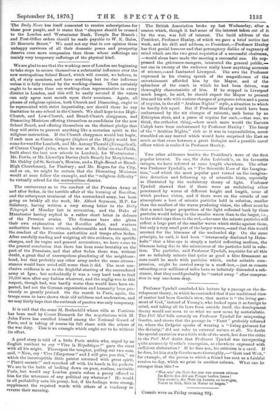Two other addresses besides the President's were of the first
popular interest. To one, Sir John Lubbock's, on his favourite savages, we have referred at some length elsewhere. The other was Professor Tyndall's, on "The Scientific Uses of the Imagina- tion,"—of which the most popular part turned on the imagina- tive detection and following up of scientific hints, especially as illustrated by the undulatory theory of light. Professor Tyndall showed that if there were an undulating ether penetrated by waves of different height and length, some of which produce vision, and if there were on the outside of our atmosphere a host of minute particles held in solution, smaller than the smallest of the waves producing vision, the effect must be that a much larger proportion of the light reflected back by these particles would belong to the smaller waves than to the larger, i.e., to the violet rays than to the red,—because the minute particles will reflect a large part of the smaller waves which strike against them, but only a very small part of the larger waves,—and that this would account for the blueness of the unclouded sky. On the same principle, he said, it had been "irreverently disclosed by Helm- holtz" that a blue eye is simply a turbid reflecting medium, the blueness being due to the minuteness of the particles held in solu- tion. The particles, said Professor Tyndall, requisite for all this are so infinitely minute that quite as good a blue firmament as ours could be made with particles which, under suitable com- pression, might be carried away in a snuff-box,—just as comets extending over millions of miles have so infinitely distended a sub- stance, that they could probably be "carted away "after compres- sion in any one-horse dray.






























 Previous page
Previous page